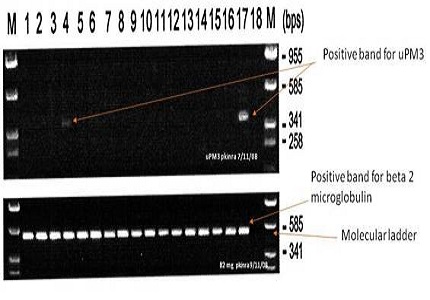Prostate cancer diagnosis by detection of uPM3 in urine
Abstract
Background: The widespread acceptance of serum PSA testing for the early detection of prostate cancer has been hampered by the low specificity and unnecessary biopsies.
Methods: This study was carried out to detect prostate cancers in patients with equivocal PSA values using RT-PCR (Reverse transciptase- polymerase chain reaction) to detect the uPM3 (urinary protein M3) in post prostatic massage urine samples. uPM3 is a mRNA released in prostate cancer patients due to the presence of the oncogene DD3 also called as PCA3 on chromosome 9.
Results: There were a total of 27 cases of prostate carcinoma and 33 cases of PIN (prostate intraepithelial neoplasia) detected in this study. The sample collection accuracy depending on presence of beta2 microglobulin (housekeping gene) band was 88%. The sensitivity and specificity of uPM3 keeping histopathology as gold standard was 85.18% and 98.78% respectively. Positive predictive value was 88.46% and negative predictive value was 98.38% which is much higher than PSA. However, no significant correlation of uPM3 positivity was found with Gleason’s grade, metastatic potential and pathological stage.
Conclusion: Unlike serum PSA, uPM3 was found to be independent of prostate volume thereby having no false positives unlike raised PSA because of large benign prostate hypertrophy.
Downloads
References
2. Arcangeli CG, Ornstein DK, Keetch DW, Andriole GL. Prostate-specific antigen as a screening test for prostate cancer. The United States experience. Urol Clin North Am. 1997 May; 24(2):299-306. Review. [PubMed]
3. Pannek J, Partin AW. Prostate-specific antigen: what's new in 1997. Oncology (Williston Park). 1997 Sep;11(9):1273-8; discussion 1279-82. [PubMed]
4. Schalken JA, Hessels D, Verhaegh G. New targets for therapy in prostate cancer: differential display code 3 (DD3(PCA3)), a highly prostate cancer-specific gene. Urology. 2003 Nov;62(5 Suppl 1):34-43. [PubMed]
5. Caldarera E, Crooks NH, Muir GH, Pavone-Macaluso M, Carmichael PL. An appraisal of telomerase activity in benign prostatic hyperplasia. Prostate. 2000 Nov 1;45(3):267-70. [PubMed]
6. Bussemakers MJ, van Bokhoven A, Verhaegh GW, Smit FP, Karthaus HF, Schalken JA, Debruyne FM, Ru N, Isaacs WB. DD3: a new prostate-specific gene, highly overexpressed in prostate cancer. Cancer Res. 1999 Dec 1;59(23):5975-9. [PubMed]
7. Hakalahti L, Vihko P, Henttu P, Autio-Harmainen H, Soini Y, Vihko R. Evaluation of PAP and PSA gene expression in prostatic hyperplasia and prostatic carcinoma using northern-blot analyses, in situ hybridization and immunohistochemical stainings with monoclonal and bispecific antibodies. Int J Cancer. 1993 Oct 21;55(4):590-7.
8. Xu LL, Stackhouse BG, Florence K, Zhang W, Shanmugam N, Sesterhenn IA, Zou Z, Srikantan V, Augustus M, Roschke V, Carter K, McLeod DG, Moul JW, Soppett D, Srivastava S. PSGR, a novel prostate-specific gene with homology to a G protein-coupled receptor, is overexpressed in prostate cancer. Cancer Res. 2000 Dec 1;60(23):6568-72.
9. Srikantan V, Zou Z, Petrovics G, Xu L, Augustus M, Davis L, Livezey JR,Connell T, Sesterhenn IA, Yoshino K, Buzard GS, Mostofi FK, McLeod DG, Moul JW, Srivastava S. PCGEM1, a prostate-specific gene, is overexpressed in prostate cancer. Proc Natl Acad Sci U S A. 2000 Oct 24;97(22):12216-21.
10. Srivastava DS, Mandhani A, Mittal B, Mittal RD. Genetic polymorphism of glutathione S-transferase genes (GSTM1, GSTT1 and GSTP1) and susceptibility to prostate cancer in Northern India. BJU Int. 2005 Jan;95(1):170-3. [PubMed]
11. Parkin DM, Bray FI, Devesa SS. Cancer burden in the year 2000. The global picture. Eur J Cancer. 2001 Oct;37 Suppl 8:S4-66. [PubMed]
12. Schröder FH. Diagnosis, characterization and potential clinical relevance of prostate cancer detected at low PSA ranges. Eur Urol. 2001 Apr;39 Suppl 4:49-53.
13. Catalona WJ, Smith DS, Ornstein DK. Prostate cancer detection in men with serum PSA concentrations of 2.6 to 4.0 ng/mL and benign prostate examination. Enhancement of specificity with free PSA measurements. JAMA. 1997 May 14;277(18):1452-5.
14. Goessl C, Müller M, Heicappell R, Krause H, Straub B, Schrader M, Miller K.DNA-based detection of prostate cancer in urine after prostatic massage. Urology.2001 Sep;58(3):335-8. [PubMed]
15. de Kok JB, Verhaegh GW, Roelofs RW, Hessels D, Kiemeney LA, Aalders TW, Swinkels DW, Schalken JA. DD3(PCA3), a very sensitive and specific marker to detect prostate tumors. Cancer Res. 2002 May 1;62(9):2695-8. [PubMed]
16. Hessels D, Klein Gunnewiek JM, van Oort I, Karthaus HF, van Leenders GJ, van Balken B, Kiemeney LA, Witjes JA, Schalken JA. DD3(PCA3)-based molecular urine analysis for the diagnosis of prostate cancer. Eur Urol. 2003 Jul;44(1):8-15; discussion 15-6. [PubMed]
17. Fradet Y, Saad F, Aprikian A, Dessureault J, Elhilali M, Trudel C, Mâsse B, Piché L, Chypre C. uPM3, a new molecular urine test for the detection of prostate cancer. Urology. 2004 Aug;64(2):311-5; discussion 315-6. [PubMed]
18. Broccoli D, Young JW, de Lange T. Telomerase activity in normal and malignant hematopoietic cells. Proc. Natl Acad Sci 1995 Sep; 92 (20): 9082-86.
19. Ruijter ET, Miller GJ, Aalders TW, van de Kaa CA, Schalken JA, Debruyne FM,Boon ME. Rapid microwave-stimulated fixation of entire prostatectomy specimens.Biomed-II MPC Study Group. J Pathol. 1997 Nov;183(3):369-75.
20. Sebo TJ, Cheville JC, Riehle DL, Lohse CM, Pankratz VS, Myers RP, Blute ML, Zincke H. Predicting prostate carcinoma volume and stage at radical prostatectomy by assessing needle biopsy specimens for percent surface area and cores positive for carcinoma, perineural invasion, Gleason score, DNA ploidy and proliferation, and preoperative serum prostate specific antigen: a report of 454 cases. Cancer. 2001 Jun 1;91(11):2196-204.
21. Hessels D, van Gils MP, van Hooij O, Jannink SA, Witjes JA, Verhaegh GW, Schalken JA. Predictive value of PCA3 in urinary sediments in determining clinico-pathological characteristics of prostate cancer. Prostate. 2010 Jan 1;70(1):10-6. doi: 10.1002/pros.21032.



 OAI - Open Archives Initiative
OAI - Open Archives Initiative


